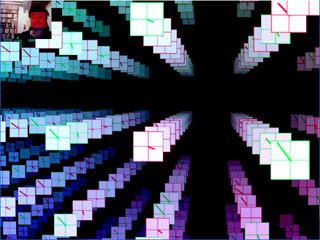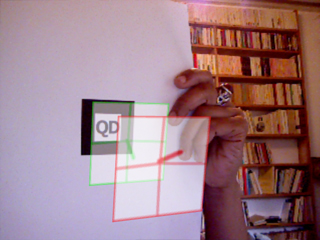 preamble preamble
 representations representations
 quantum algorithms quantum algorithms
 quantum information quantum information
 prospects prospects
 3D and augmented reality 3D and augmented reality
 logical propositions logical propositions
 next steps next steps
 Thanks to... Thanks to...
|
|
|
|
3D and augmented reality
The tools we have shown until now have been only in 2D.
Below we have tried to implement 3D representations.
1. To observe.
The first attempt led to an experiment that requires a webcam. Filming you with the webcam forces you to move your face in order to observe a big register of qubits.
As it is a draft, the constraint on the sum of squared modules is not respected.
To access the interface, please click on the image.
|

|
2. Augmented reality
An attempt more relevant in the context of this project. Using the techniques of augmented reality
to show the impact of a base-change on the linear combination representing the superposition of qubit states.
You must first print the TAG, a pattern that will be recognized by the camera. The tag is available >here<.
To access the interface, please click on the image of my hand.
Put the TAG in front of the camera. You'll see a qubit in a superposition of states.
When the TAG is facing the camera, you will see a |0>.
By directing the TAG differently along the vertical axis, you will see the impact of the base rotation:
Amplitudes vary and thus alter the opacity of the plans.
By tilting the TAG along the horizontal axis, the superposition does not change but you can still observe it.
|

|
Note: The interface was developed in Flash, you will be asked to confirm the activation of your webcam.
We assure you that no recording will be made.
Sources :
Mr Doob for the first experiment : http://mrdoob.com
flartoolkit and papervision3D for the augmented reality : http://blog.papervision3d.org/2009/01/07/augmented-reality-with-flartoolkit/
|
|